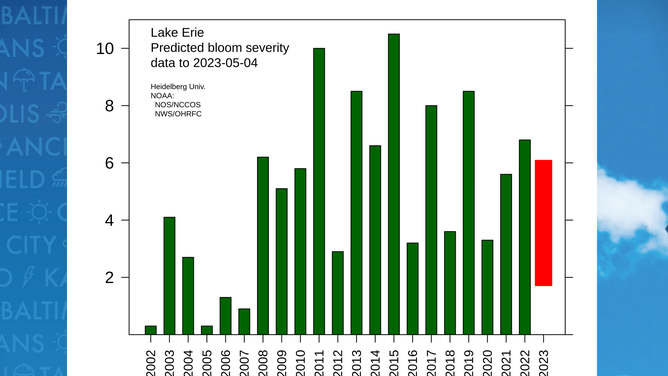Harmful algal bloom expected along Great Lakes this summer
Experts say the bloom’s severity will depend on how much phosphorus makes its way from rivers and creeks into the lake. Lake Erie is the fourth largest of the five Great Lakes and where water temperatures are typically the warmest.
Lake Erie water quality flight overiew
Engineers at NASA's Glenn Research Center in Cleveland used remote-sensing technology to learn more about a Lake Erie algal bloom in 2014 .
CLEVELAND – NOAA expects a harmful algal bloom to take over parts of Lake Erie during the summer, which could mean problems for visitors and residents who rely on a healthy waterway for recreation and daily life.
The agency released its first seasonal outlook for the lake Thursday, which called for readings to reach between a level 2 and 6 on the severity scale.
The size of the expected algae is around last year’s levels but significantly lower than blooms in 2011 and 2015.
A level of 5 or greater on the severity index can pose a risk to drinking water and recreation along the lake.
RED TIDE TRACKER: FLORIDA BEACHES FACE RED TIDE THREAT AS TRAVELERS HEAD SOUTH IN SEARCH OF SUNSHINE

Blooms with a severity index above 5 pose a risk to drinking water. During 2011the level reached 10 and in 2015 reached 10.5.
(NOAA)
According to Michigan’s Department of Environment, Great Lakes and Energy, blooms along the lake consist of blue-green algae, otherwise known as cyanobacteria, which produces a liver toxin.
Significant amounts of phosphorus, which are used in industrial and agricultural operations, can run off into rivers and streams, leading to the growth of plants and algae in bodies of water. Environmentalists have fought for years for increased protection against phosphorus runoff, and the issue is currently in federal court. A judge based in the Northern District of Ohio ruled on Thursday that the state’s EPA must create an action plan to address toxic algae blooms that plague western Lake Erie every summer.
"Though the work that today’s agreement brings is but a first step, it is a step that has to be taken," said Judge James Carr in a statement. How many more steps lie ahead, and how long they will take, is beyond even guessing. But there’s reason to hope that, in time, the Maumee River will no longer display, as it has for countless summers, a loathsome foul and slimy green surface as it flows through Toledo on its constant and irresistible course on to Lake Erie’s Western Basin."
In 2014, a bloom tied to runoff caused unsafe levels of microcystins in the water system of Toledo, Ohio. About a half-million people were urged not to use the precious resource for three days until testing gave the all-clear. The city was the first major community in the U.S. where microcystins caused the water quality to drop to potentially unsafe levels.
WATCH: LAST BITS OF ICE HUG LAKE ERIE SHORE AMID NEAR-RECORD ICE MELT
According to experts, people and wildlife can suffer skin rashes, illnesses and even death if the algal toxins are ingested.
NOAA reported an estimated 30 million people in Canada and the U.S. rely on the Great Lakes for drinking water.
Forecasters believe if precipitation remains at or below average over the Great Lakes region, a less severe bloom will be likely because of reduced runoff.
NOAA plans on issuing weekly reports on the status of blooms during the summer and will release an updated seasonal forecast for Lake Erie on June 29.




